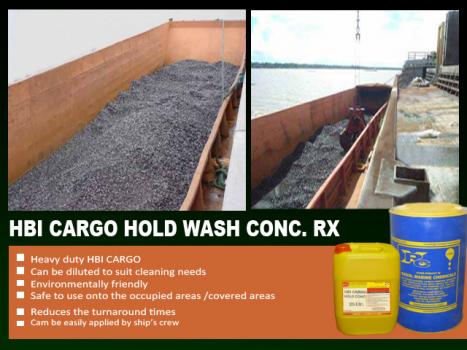HBI CARGO Hold Wash Concentrate RX
HBI at Elevated Temperatures
The Master of the ship must notify the port authorities if hydrogen gas is detected in the ship holds or if abnormal temperatures are measured in the HBI cargo holds. The Harbor Master and qualified personnel are responsible for executing the action plan when a ship or barge arrives with HBI at the following temperature levels:
A. Greater Than 65° Celsius but Less Than or Equal to 80° Celsius
Proceed with the following actions:
1 > Before unloading the vessel, measure the HBI temperature in each hold and record the measurements in the temperature log book.
2 > Unload the holds in the assigned zone and immediately transfer the HBI to the storage yard zone as described in PART II, Section 5.4 of this guide.
B. Temperature Greater Than 80° Celsius and Less Than or Equal to 150°
Celsius
Proceed with the following actions:
1 > Before unloading the vessel, measure the HBI temperature in each hold and record the measurements in the temperature log book. This should be done every two hours while the contingency is in effect.
2 > Unload the holds with HBI at temperature less than 65º Celsius first, then those containing HBI between 65º and 100º Celsius. Continue unloading HBI with temperatures between 100º and 150º Celsius in the
first transfer station, using the movement sense of the belt as a
reference.
3 > Transfer the HBI from the unloading zone clean and free of debris and flammable material, such as coal, coke and wood to the storage yard indicated by the client as follows:
Transfer the HBI during a maximum of three-minute intervals, and dose (i.e., mix the hotter with the cooler material to have an average temperature lower than the hottest one – no water to be used) the HBI that is at temperatures between 100° and 150° Celsius with cooler material for a maximum of two minutes. Stop the vibrating feeders for about five minutes, but keep the conveyor belts in motion. Repeat these steps until finished with HBI removal. While transferring the HBI, inspect the belt transfer system for any sign of overheating. In case of belt overheating, stop the HBI dosing and transfer but keep the transfer belts in motion until they cool. Take special care to avoid pouring water into hoppers and other equipment. Use a front-end loader to spread the HBI to a level of approximate 30 centimeter height to stop the reoxidation, Verify that the belts are cooled down and resume HBI transfer per
the previous instructions.
C . Greater than 150° Celsius
Proceed with the following actions:
1 > Before unloading the holds, measure the HBI temperature in each hold and record the measurements in the temperature log book. This should be done every two hours while the contingency is in effect.
2 > Position the HBI with temperatures greater than 150° Celsius at the end of the reception area and spray with pressurized water. In this case, there is no option but to momentarily cool down the HBI.
3 > When the temperature is reduced to between 80º and 150° Celsius proceed with the steps described in 6.3.2.2. Caution: Do not spray water on hot HBI that is steaming (i.e., emitting water vapor).
Procedure If Hydrogen Concentration Is Over 1% (25% LEL)
1 > Inform the shipper immediately and seek expert advice.
2 > Keep the natural surface ventilation open at all times
3 > Monitor LEL in the holds continuously until level drops to less than 25 %.
4 > Avoid any possible ignition source on the vicinity.
5 > Care shall be taken as to prevent any spark generation.
6 > Monitor the hydrogen concentration in the holds and keep the surface ventilation (either natural or mechanical) until values fall below 1%.
7 > When hydrogen levels are within safe values, proceed as normal.
8 > On the contrary, additional ventilation should be applied to the space if available and re-testing should be conducted after a suitable interval.
9 > Contact the P & I Club and Shipper and follow the instructions of the appointed expert or surveyor.
10 > At sea, do not open the troubled hold without explicit instructions from the shipper or appointed expert or surveyor.
11 > Ensure there are no possible sources of ignition near the cargo spaces, adjacent spaces or open decks.
Tips for general cleaning of Cargo Holds.
1st step is Manual Cleaning: First of all try to remove all loose / deposited cargo, live & dead insect & weevils from Holds frames, beams, girders, and other structure by manual swiping or air blown pressure method. This step not only help to consume less clean requirement but also loose debris cargo materials can mess entire surface with contact of a liquid solution, further can kill more time.
2nd Step is Inspection: After following the 1st method of manual cleaning try to remove loose rust/paint skin from the metal surface, For this step Metal Clean Bright Rust remover and paint remover can save more time other than manual scraping cleaning methods. As we observe that only 25 ltrs to 50 Ltrs of Metal Clean Bright is sufficient to complete this step of cleaning of Bulkheads, upper and lower hopper spaces, underneath of Hatch Covers and the tank top.
3rd step is for Wise Decision for selection of suitable cleaner : Then apply selected hold cleaning agent like ALKAATUFF Ship Hold Cleaner, hold bright, Alkaclean, Coal Remover, Cement remover, Hodwash, Rock Phosphate cleaner, HBI cleaning agent, Sodium Hypo, Muriatic Acid, Citric Acid, Fore and Aft, PCS hold cleaner, Teepol and other detergent cleaners. Before selection of any cargo hold cleaning detergent understand chemical property of cleaner and actual requirement, For example, if cargo is lime then Lime Remover can works better then ALKAATUFF Ship Hold Cleaner. As lime contains alkaline component when it comes in contact with moisture, solidification starts which becomes hard solid deposition. The hard solid lime deposit can be easily broken in to lose muddy mass by application of RXSOL LIME WASH, Its chemical formula is effectively neutralized alkaline content of LIME. Similarly, cement remover, Coal Remover and other specialized hold cleaner contain specialized materials to work fast on specific cargo.
4th step is for Bilge Area: Bilge covers should be cleaned of any cargo residues. Check each and every drain hole should be open and Bilge cover must be covered with BURLAP, not with plastic or other watertight materials ( for ready reference pl. click here ). And Bilge tank should be cleaned and odour free by using suitable detergent with deodorizer and antibacterial properties. Chemically ppm level of potassium permanganate can play best role which is not only disinfected surface but also can deodorize the tank.
Available stock at Kandla, Mundra ( Gandhidham ), Mumbai, JNPT - Nhava Seva, Goa, Manglore, Vishakhaptnam - Vizag, Gangavaram, kakinada, Chennia - Ennore, Tuticorin, Kolkata - Haldia, Paradip - INDIA and All middle east port - Dubai, Sharjah, Fujairah, Abu Dhabi
Other Valuable Hold Cleaners :::
Cement Remover RX Hold ::: Highly concentrated and powerful penetrating agents materials which is effectively react with cement to loosen the bonding strength . Best results can obtain on dry surface of cement. RXSOL'S R & D has developed this molecular cement dissolver. Part No.- RXSOL-22-2202-025, Part No.- RXSOL-22-2202-020, Part No.- RXSOL-22-2202-050
RX MARINE INTERNATIONAL is most popular chemicals source in INDIA, Keeping ready stock at 5 LOCATION which includes Mumbai, Kandla - Gandhidham, Vizag - Visakhapatnam, Ennore - Chennai, Kolkata more then 3000 types of chemicals. Please click here to get PRODUCT Categories details http://rxmarine.com/Products
Mail Us for any PRODUCT related information and purchase inquiry : rxmarinechemical@gmail.com ( This mail is for customer / Buyer only ) And if you wants to add your hand as a supplier, And if you have volume manufacturing capacity of chemicals, pl. drop your mail at rxmarinechemical@gmail.com ( This mail is for supplier only )
































